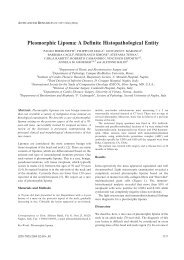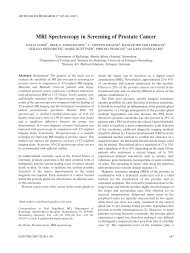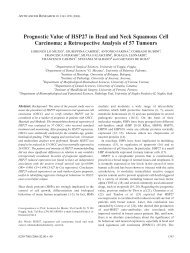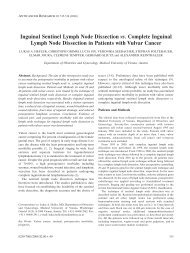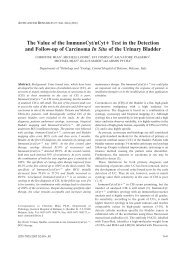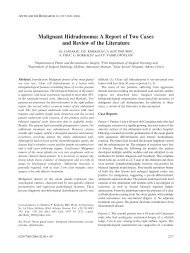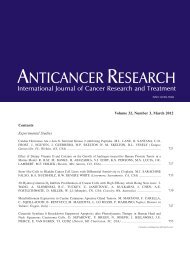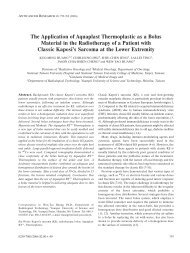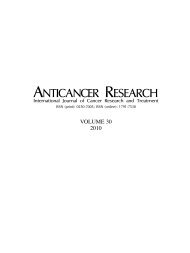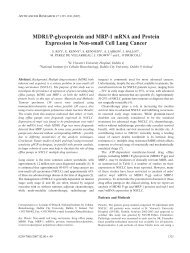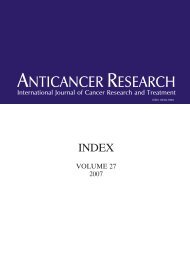ABSTRACTS OF THE 21st ANNUAL MEETING OF THE ITALIAN ...
ABSTRACTS OF THE 21st ANNUAL MEETING OF THE ITALIAN ...
ABSTRACTS OF THE 21st ANNUAL MEETING OF THE ITALIAN ...
Create successful ePaper yourself
Turn your PDF publications into a flip-book with our unique Google optimized e-Paper software.
Abstracts of the <strong>21st</strong> Annual Meeting of the Italian Society of Uro-Oncology (SIUrO), 22-24 June, 2011, Naples, Italy<br />
1 Urologia, 2 Patologia Clinica, 5 Oncologia Medica, Università<br />
degli studi Federico II, Napoli, Italy;<br />
3 Urologia, Umberto I Nocera Inferiore, Salerno, Italy;<br />
4 Urologia, Istituto dei Tumori Napoli, Napoli, Italy<br />
Background: PSA has been widely used for the detection of<br />
prostate cancer (PCa) for more than two decades. However,<br />
the major drawback of PSA is its relative lack of specificity,<br />
most of all in the critical diagnostic range of 4-10 ng/ml, with<br />
a large consequent number of unnecessary prostate biopsies.<br />
PSA is organ specific but not cancer specific. Thus, serum<br />
levels may be elevated in the presence of benign prostatic<br />
hyperplasia (BPH), prostatitis and other non-malignant<br />
conditions. A significant improvement in the discrimination of<br />
PCa from BPH was achieved by evaluating the serum free-tototal<br />
PSA ratio. Free PSA (fPSA) comprises different<br />
subforms of inactive PSA, such as the pro-enzyme called pro-<br />
PSA. Recently, with this aim, the prostate health index PHI<br />
has been proposed, calculated according to the formula<br />
PHI=(p2PSA/fPSA)×√tPSA, where tPSA is the total PSA and<br />
p2PSA is a PSA isoform. Patients and Methods: We tested the<br />
ability of the PHI to discriminate between benign and<br />
malignant disease in a population composed of 120 patients<br />
[49 with BPH, 38 with PCa and 33 with precancerous lesions,<br />
such as prostatic intraepithelial neoplasia (PIN) and atypical<br />
small acinar proliferation (ASAP)]. Results: We found that<br />
median PHI levels were significantly higher in PCa patients<br />
compared with either BPH or precancerous patients (p=0.005<br />
and 0.034, respectively). ROC curve analysis confirmed this<br />
finding (AUC=0.67 for either comparison, BPH vs. PCa or<br />
PIN, and ASAP vs. PCa). Conclusion: The prostate health<br />
index PHI seems to be able to discriminate PCa from BPH,<br />
PIN and ASAP.<br />
1 Le BV, Griffin CR, Loeb S et al: -2,Proenzyme prostatespecific<br />
antigen is more accurate than total and free prostatespecific<br />
antigen in differentiating prostate cancer from<br />
benign disease in a prospective prostate cancer screening<br />
study. J Urol 183: 1355-1359, 2010.<br />
2 Jansen FH, van Schaik RH, Kurstjens J et al: Prostatespecific<br />
antigen (PSA) isoform p2PSA in combination with<br />
total PSA and free PSA improves diagnostic accuracy in<br />
prostate cancer detection. Eur Urol 57: 921-927, 2010.<br />
3 Sokoll LJ, Sanda MG, Feng Z et al: A prospective,<br />
multicenter, National Cancer Institute Early Detection<br />
Research Network study of -2,proPSA: improving prostate<br />
cancer detection and correlating with cancer aggressiveness.<br />
Cancer Epidemiol Biomarkers Prev 19: 1193-1200, 2010.<br />
200<br />
PATHOLOGICAL OUTCOMES <strong>OF</strong> CANDIDATES<br />
FOR PRIAS AND JOHNS HOPKINS ACTIVE<br />
SURVEILLANCE PROTOCOLS TREATED WITH<br />
IMMEDIATE RADICAL PROSTATECTOMY<br />
Vito Lacetera1 , Andrea Galosi1 , Alessandro Conti1 ,<br />
Daniele Cantoro1 , Roberta Mazzucchelli2 ,<br />
Rodolfo Montironi2 and Giovanni Muzzonigro1 1Institute of Urology and 2Institute of Pathology, Azienda<br />
Ospedaliera, Universitaria Ospedali Riuniti, Polytechnic<br />
University of Marche Region, Ancona, Italy<br />
Background: Active surveillance (AS) represents an emerging<br />
option for selected patients with low-risk prostate cancer. The<br />
aim of AS is to decrease the rate of definitive therapy and its<br />
side-effects in patients whose biological tumor characteristics<br />
pose a minimal threat to their life expectancy. We tested the<br />
two most commonly used European and American AS<br />
protocols (PRIAS (1) and John Hopkins (JHP) (2),<br />
respectively) in patients who met their selective entry criteria,<br />
but underwent radical prostatectomy (RP) as first-choice<br />
treatment, in particular their ability to correctly select patients<br />
with low-risk prostate cancer, excluding patients with<br />
unfavorable prostate cancer characteristics at final pathological<br />
examination. Patients and Methods: The records regarding a<br />
total of 616 patients were extracted from our institutional<br />
urological oncology database of all men who underwent<br />
radical prostatectomy between 2005-2010. For all patients, full<br />
records of biopsy and RP specimen pathological reports were<br />
available. Following central review of all slides, pathological<br />
tumor volumes were calculated using 3-D stereology (as the<br />
product of tumor area per section and thickness section) based<br />
on a whole-mount section 3-mm step analysis. We selected<br />
two groups of patients: firstly, those who met the PRIAS<br />
inclusion criteria, namely: T1-cT2, biopsy Gleason ≤3+3, PSA<br />
≤10, PSA density



